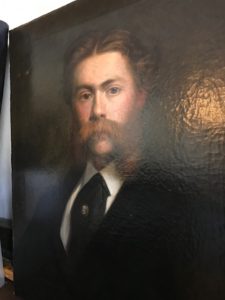 MMG crammed many lives into one glorious one as a tennis pro, interior designer, and antiques dealer, and now wants to downsize. She sent me photos of her collections. One image caught my eye, an ancestor portrait of someone she thought might have been an emperor. People often ask me to date an ancestor portrait, unsigned, although it may be the least valuable of their treasures. Because this guy looks like an overdressed Hugh Jackman, I will date this portrait.
MMG crammed many lives into one glorious one as a tennis pro, interior designer, and antiques dealer, and now wants to downsize. She sent me photos of her collections. One image caught my eye, an ancestor portrait of someone she thought might have been an emperor. People often ask me to date an ancestor portrait, unsigned, although it may be the least valuable of their treasures. Because this guy looks like an overdressed Hugh Jackman, I will date this portrait.
If the image shows a gentleman, I date a portrait by the tie. The tie becomes tantamount, as styles in neckwear changed faster than coats. Neckties are ancient, the word goes back to the Egyptian for Isis Knot: Tyet.
Enter the Cravat
In the 17th century a new style of necktie emerged called the cravat, after the Croats, mercenaries to Louis XIII. They wore a loose band around the neck, emulated by the noblemen of France. The cravat went out of favor for the bristly round starched collar called the stock (think of Dutch portraits) worn throughout Europe. A group of noblemen in England, the Marconis, decided to change that stock for something more elegant, and they reintroduced the cravat a white band of linen, overlapping, in 1780.
The Court d’Orsay introduced the black cravat on a pure linen white shirt. As Queen Victoria took the throne, the cravat became a symbol of wealth and position. The less showy the cravat, the more status a man obtained. Add to this the one accessory of jewelry acceptable, the stick pin. The more subtle the cravat, the more symbolic the stickpin. The theme disclosed your tastes, the horseshoe, or the gold fox head, introduced in the 1850’s, worn by the ‘best’ men on a silk black cravat.
The Ancestor Portrait Denouement:
This man dates to the middle to late 1870’s when they based stick pins of fashion on naturalistic elements, such as shapes of flowers, made from natural materials, such as shells. In fact, the sitter in this portrait wears a cameo carved out of mother of pearl, and features what looks like a Classical Roman bust portrait. This gives evidence of a sitting during the Classical Revival Period, 1870-1880.
I don’t put the portrait in the late 1890’s because the evidence of the fashion for mutton chops, and the thinner collar. Earlier than the 1870’s the coat would feature dropping shoulders. I don’t place the portrait in the late 1880’s or 1890’s because the “look” of that era was ‘dandified’ with more accessories, such as a pocket square or a pearl or diamond stick pin.
Mutton Chops
The mutton chop, sideburns grown bushy with the beard at the chin shaved, retaining a dropping luxuriant mustache, said something. Mutton chops brought problems, too.
Mutton chops became so dangerous on sports fields that colleges forbid athletes to ‘sport’ them. The expression to “bust one’s chops’ hearkens to the days when an opponent grabbed your mutton chop and did some damage.
For this same reason military men of the late 1870’s -1880’s might shy away form this style of facial hair. Instead military men became big wearers. Soldiers considered shaving on the battle filed a luxury, and the upper ranks adopted the style to honor the unshaven soldier. Ole Burnside, of the Union Army made this proper.
‘Reading’ the Ancestor Portrait
Members of the middle to upper class of the late 1870’s ‘read’ this portrait. They thought the gent young but intellectual (longer middle parted hair), his overgrown facial hair points to a dominant male, upper middle class or better (black coat, black cravat, cameo stick pin, a fine white linen shirt with starched collar), and he appears well educated.
As to country of origin, something suggests American, perhaps the sober gaze, perhaps the classical cameo. We in the USA became big fans of the Classical Revival. Every small town bank building was remodeled to resemble the Parthenon in the 1870-80’s. American men were thought serious, unlike the jovial British upper class.
The value of the portrait is negligible for two reasons. One, he is not a pretty young lady. Two, he is not an emperor, because of the upper middle class flavor of the classical cameo stick pin, affordable if you had some money. I put the value at $800.